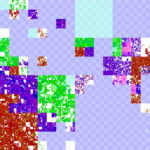The paper “Towards Geolocation of Millions of IP Addresses” was accepted by IMC 2012 in Boston, MA (available at http://www.isi.edu/~johnh/PAPERS/Hu12a.html).
From the abstract:
Previous measurement-based IP geolocation algorithms have focused on accuracy, studying a few targets with increasingly sophisticated algorithms taking measurements from tens of vantage points (VPs). In this paper, we study how to scale up existing measurement-based geolocation algorithms like Shortest Ping and CBG to cover the whole Internet. We show that with many vantage points, VP proximity to the target is the most important factor affecting accuracy. This observation suggests our new algorithm that selects the best few VPs for each target from many candidates. This approach addresses the main bottleneck to geolocation scalability: minimizing traffic into each target (and also out of each VP) while maintaining accuracy. Using this approach we have currently geolocated about 35% of the allocated, unicast, IPv4 address-space (about 85% of the addresses in the Internet that can be directly geolocated). We visualize our geolocation results on a web-based address-space browser.
Citation: Zi Hu and John Heidemann and Yuri Pradkin. Towards Geolocation of Millions of IP Addresses. In Proceedings of the ACM Internet Measurement Conference, p. to appear. Boston, MA, USA, ACM. 2012. <http://www.isi.edu/~johnh/PAPERS/Hu12a.html>

![Visualization of low-rate periodicity, before and after installation of a keylogger. [Bartlett11a, figure 3]](http://ant.isi.edu/blog/wp-content/uploads/2011/04/Bartlett11a_icon-227x300.png)